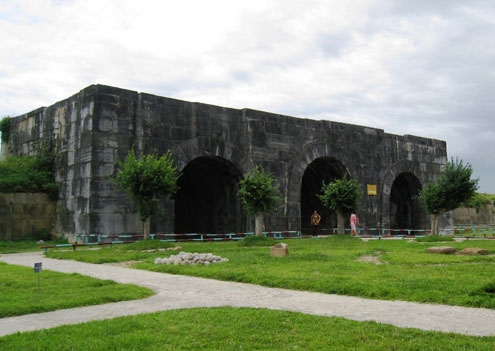Ho Dynasty Citadel recalls history

The world cultural heritage site in Thanh Hoa Province will receive its certificate this weekend and it is about time people appreciated this piece of the nation’s history.
The relic stretching over two communes of Vinh Long and Vinh Tien in Vinh Loc District used to be the capital of Vietnam from 1397 to 1407 but it seems UNESCO’s recognition has been the catalyst to make people sit up and take notice of its existence.
Built around 600 years ago, with four gates facing south, north, east and west, the Ho Dynasty Citadel is a stone military architecture with great cultural and historical value.
The citadel includes three sections: La Thanh and bamboo hedge, moat and citadel wall, and an internal area with a number of palaces connected to one another by marble-paved roads.
It measures 870 meters by 830 meters. Outside the citadel there is Bao Thanh (Ly Cung) palace, which is known as the altar of the sky and the earth.
The citadel was built using huge square stone stabs which are 5.1 meters long, 1.59 meters wide and 1.3 meters high, some of them weighing 15-20 tons. They overlap each other without any substance to hold them together and have stood strong for six centuries.
It is strategically located so that it can be defended from attackers. The citadel is protected by a mountain range to the north, while the Ma River runs to the west and the Buoi River to the south, creating a huge natural moat.
Most of its main structures have been seriously damaged, while only the wall and four main entrances are well preserved. Therefore, tourists to the site often spend only 10 minutes to look at the walls and admire the immense rice fields around to recall a glorious historical time.
This is the main reason why the site is desperately in need of preservation and re-development as its historical value alone should bring in the tourists.
Although the Ho Dynasty only lasted from 1400 to 1407, Emperor Ho left a significant legacy. He is credited for pioneering the circulation of the first banknotes in Vietnam, expanding the network of schools and promoting the use of the Vietnamese Nom ideographic script.
The site has been excavated since 2004. Archeologists have found artifacts made from baked bricks, stone marbles, tiles shaped like dragons, stone bullets, arrows and nails and household pottery inside the citadel.
What the stars mean:
★ Poor ★ ★ Promising ★★★ Good ★★★★ Very good ★★★★★ Exceptional
 Tag:
Tag:
Related Contents
Latest News
More News
- The destinations powering Vietnam’s festive season travel demand (December 04, 2025 | 18:33)
- Vietnam named among the world’s most exciting winter destinations (December 04, 2025 | 15:10)
- Phu Tho emerges as northern Vietnam’s new tourism hub (December 01, 2025 | 17:00)
- Vietjet completes Airbus A320/A321 updates ahead of deadline (December 01, 2025 | 09:49)
- Vietjet resumes Con Dao flights from early December (November 28, 2025 | 15:24)
- Free tickets, Lunar New Year promotions on offer at Vietjet Mega Livestream (November 26, 2025 | 15:32)
- Scandinavian Airlines and Vietnam Airlines broaden agreement with new routes (November 25, 2025 | 17:04)
- Halong Cruise Port welcomes over 3,100 international visitors (November 12, 2025 | 18:06)
- Vietnam.travel climbs to second place in Southeast Asia website rankings (November 12, 2025 | 18:01)
- Cat Ba named among Southeast Asia’s top island adventures (November 11, 2025 | 18:09)




















 Mobile Version
Mobile Version